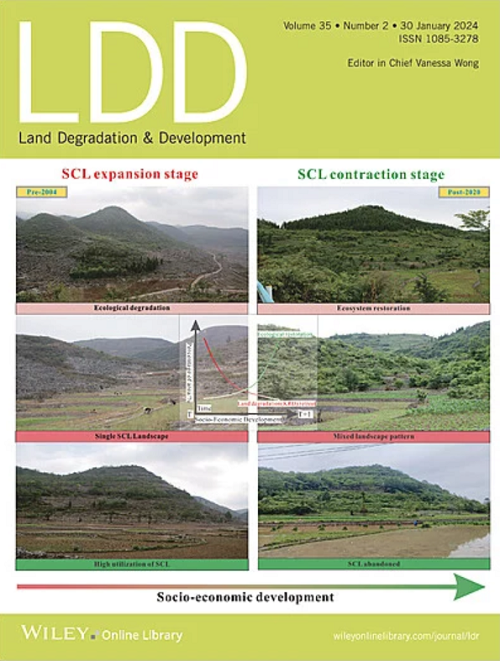基于遥感和机器学习的森林地上生物量密度估算:RSME方法
IF 3.7
2区 农林科学
Q2 ENVIRONMENTAL SCIENCES
引用次数: 0
摘要
准确估计地上生物量(AGB)密度对于有效的森林管理、碳储量监测和明智的土地管理决策至关重要。本研究采用遥感数据集,并与ArcGIS合作建立登嘉楼地区AGB密度模型。该方法与谷歌Earth Engine中的随机森林算法相结合,以1公里的空间分辨率进行AGB密度建模,并结合了GEDI 4级、Sentinel‐1雷达、Sentinel‐2光学图像和高程/坡度图。验证结果表明,均方根误差(RMSE)为51.35 t /公顷,平均训练误差为31.82 t /公顷,证明了模型的准确性和可靠性。该模型的强预测性能(R2 = 0.77)表明自变量占AGB变异性的77%。丁加奴地区平均AGB为90.94 t /公顷,标准差为64.52 t /公顷,AGB值在16.89 ~ 206.99 t /公顷之间。这些发现突出了整合多个遥感数据源进行综合AGB密度制图的潜力,从而加强对森林碳储量的监测并促进知情管理方法。这项研究强调了开放获取数据和基于云的技术的重要性,从而支持了实施可比项目的工具的可用性。该研究说明了将不同数据集和机器学习技术结合起来进行森林生物量远程评估的重要性,从而促进了生态系统特征和可持续性倡议的改进建模。通过强调对先进技术和合作战略的需求,本研究加强了森林生物量评估,并支持知情的环境管理实践。本文章由计算机程序翻译,如有差异,请以英文原文为准。
Estimating Forest Aboveground Biomass Density Using Remote Sensing and Machine Learning: A RSME Approach
An accurate estimation of aboveground biomass (AGB) density is essential for effective forest management, carbon stock monitoring, and informed land management decisions. This study employs remote sensing datasets and collaborative efforts with ArcGIS to model AGB density across the Terengganu region. Integrated with the random forest algorithm in the Google Earth Engine for AGB density modeling at a spatial resolution of 1 km, the methodology incorporates GEDI Level 4, Sentinel‐1 radar, Sentinel‐2 optical imagery, and elevation/slope maps. The validation results indicated a root mean square error (RMSE) of 51.35 t per hectare and an average training error of 31.82 t per hectare, demonstrating the model's accuracy and reliability. The model's strong predictive performance (R 2 = 0.77) implies that the independent variables accounted for 77% of the variability in the AGB. With a standard deviation of 64.52 t per hectare, the average AGB in the Terengganu area was 90.94 t per hectare, with AGB values ranging widely from 16.89 to 206.99 t per hectare across the region. These findings highlight the potential of integrating multiple remote sensing data sources for comprehensive AGB density mapping, thereby enhancing the monitoring of forest carbon stocks and fostering informed management approaches. This study underscores the importance of open‐access data and cloud‐based technologies, thereby supporting the availability of tools to implement comparable projects. This research illustrates the significance of combining different datasets and machine learning techniques for the remote assessment of forest biomass, thereby facilitating the improved modeling of ecosystem characteristics and sustainability initiatives. By emphasizing the need for advanced technologies and collaborative strategies, this study enhances forest biomass assessments and supports informed environmental management practices.
求助全文
通过发布文献求助,成功后即可免费获取论文全文。
去求助
来源期刊

Land Degradation & Development
农林科学-环境科学
CiteScore
7.70
自引率
8.50%
发文量
379
审稿时长
5.5 months
期刊介绍:
Land Degradation & Development is an international journal which seeks to promote rational study of the recognition, monitoring, control and rehabilitation of degradation in terrestrial environments. The journal focuses on:
- what land degradation is;
- what causes land degradation;
- the impacts of land degradation
- the scale of land degradation;
- the history, current status or future trends of land degradation;
- avoidance, mitigation and control of land degradation;
- remedial actions to rehabilitate or restore degraded land;
- sustainable land management.
 求助内容:
求助内容: 应助结果提醒方式:
应助结果提醒方式:


